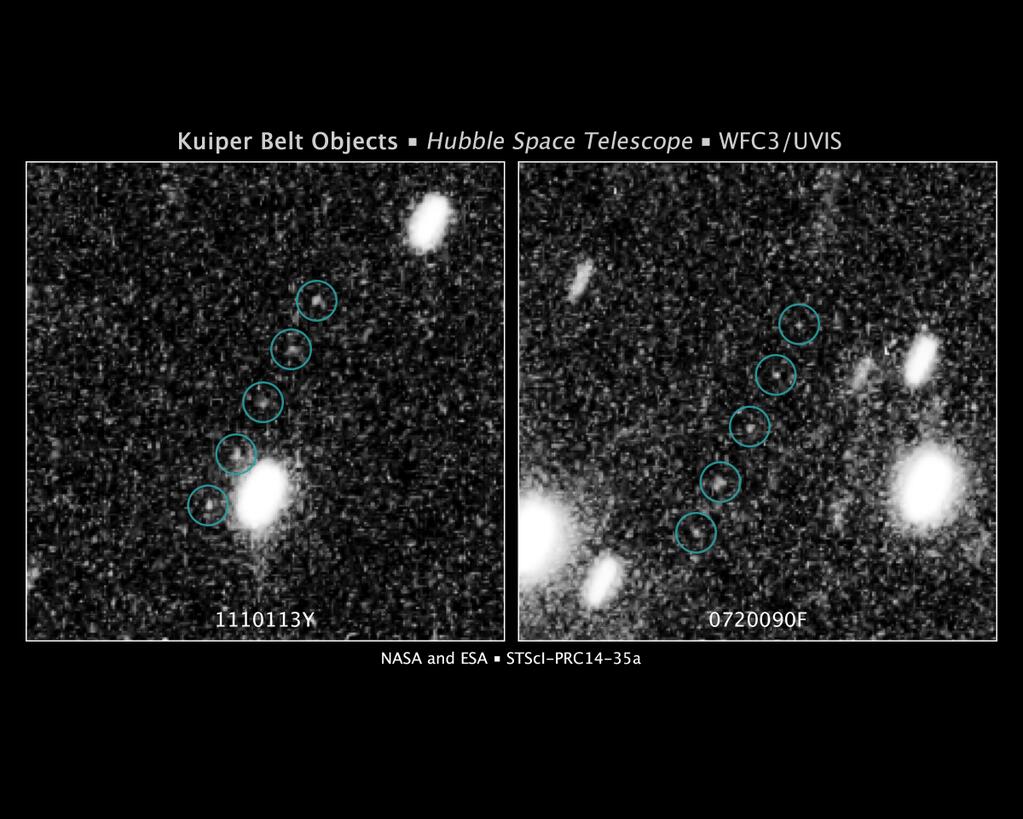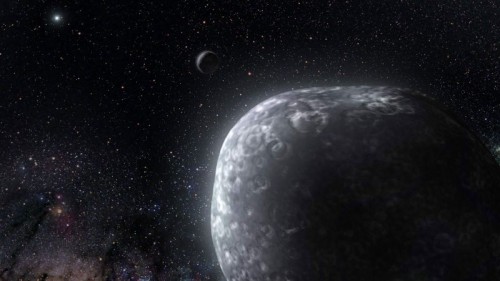
Excitement is steadily mounting as NASA’s New Horizons spacecraft races toward Pluto in the outer reaches of the Solar System, for its long-awaited flyby of the dwarf planet in July 2015. Yet one question has been on everyone’s mind on the mission team for quite some time: What’s next? An ongoing pilot survey undertaken by the mission’s science team, using NASA’s Hubble Space Telescope in recent weeks, has began to bear fruit by discovering a pair of Kuiper Belt Objects, or KBOs, that could potentially act as science targets for the spacecraft following its encounter with Pluto. In addition, this discovery has earned the mission’s science team additional observing time on the space telescope, for conducting a full-scale search in order to locate more such icy worlds, which could ensure an extended mission for New Horizons.
With the successful flyby of Neptune by the Voyager 2 spacecraft in 1989, planetary scientists had concluded the first preliminary reconnaissance of the Solar System with all major planets having been visited, albeit briefly, by robotic interplanetary probes. All planets, that is, except oddball Pluto, a distant, mysterious world, located deep into the vast, uncharted territory that lays beyond the orbit of Neptune. The discovery of the first trans-Neptunian minor icy Solar System bodies during the early 1990s confirmed the existence of a previously hypothesized frozen realm of probably tens of thousands of such minor planetary bodies at the very edges of the Solar System, better known as the Kuiper Belt. Over time, a growing realisation emerged that instead of being just an oddball planet in the context of the Solar System, Pluto was one of the biggest members of the Kuiper Belt, which represented the Solar System’s third major realm beyond that of the terrestrial and the gas giant planets.
Launched in January 2006, NASA’s New Horizons spacecraft was tasked with the exploration of this unknown realm, following its passage through the Plutonian system and its menagerie of five moons. While a suitable Kuiper Belt object laying close to New Horizons’ flight path hadn’t been identified, it was hoped that in the years following launch the mission’s science team would be able to pinpoint several such candidate targets for the spacecraft to visit. Yet, even though scientists ultimately discovered more than 50 KBOs around Pluto’s wider neighborhood after searching for many years with some of the biggest ground-based telescopes, these were all found in orbits that would require more fuel than what was available onboard New Horizons to be reached. With the clock ticking toward next year’s Pluto flyby, the mission’s science team had until the end of the year to locate a suitable KBO target for New Horizons to flyby and calculate the appropriate trajectory correction maneuvers. But as is often the case in space exploration, persistence is the key to success. Not willing to admit defeat, the New Horizons team, feeling confident in the superior observing abilities of the Hubble Space Telescope, applied for some observing time on the orbiting observatory late last year, which was finally granted in mid-June. Now, the team’s confidence seems to have paid off.

During their pilot search with Hubble, scientists were able to discover two very faint KBOs at a distance of approximately 4 billion miles (6.4 billion km) that had gone unnoticed by previous ground-based observations, due to their very small apparent magnitudes of 26.8 and 27.3 respectively, which indicates a diameter no bigger than 20 miles (32 km) across. These new KBOs were discovered after an extensive analysis of approximately 200 photographs of 20 different star fields taken with the Hubble’s Wide Field Camera 3 (WFC3) and Advanced Camera for Surveys (ACS) between June 16 and June 26, during a total of 40 Hubble orbits (the equivalent of 2.5 days’ worth of observations). Using sophisticated image-processing algorithms to block out the light of background stars, scientists were able to identify the motion of the two faint KBOs in a series of multiple exposures taken approximately 10 minutes apart, while once more showcasing Hubble’s unmatched value as an orbiting astronomical observatory. “Once again, the Hubble Space Telescope has demonstrated the ability to explore the Universe in new and unexpected ways,” says John Grunsfeld, Associate Administrator for the Science Mission Directorate at NASA Headquarters in Washington, D.C. “Hubble science is at its best when it works in concert with other NASA missions and ground-based observatories.”
Despite being a fascinating discovery, additional work is required before it can be established that the orbits of these newly found objects make them suitable targets for the New Horizons spacecraft. In the meantime, having met their goal of identifying at least two KBOs during their pilot Hubble search, the mission’s science team has been given the green light by the Space Telescope Science Institute’s Hubble Space Telescope Time Allocation Committee to proceed with a wider search until the end of August during a total of 160 Hubble orbits, in the hopes of discovering more such objects, thus increasing the chances of finding an optimal target. “I am delighted that our initial investment of Hubble time paid off,” says Dr. Matt Mountain, Director of the Space Telescope Science Institute (STScI) in Baltimore, Md. “We are looking forward see if the team can find a suitable KBO that New Horizons might be able to visit after its flyby of Pluto.”
Given the unsurpassed capabilities of the Hubble Space Telescope, the chances for finally ensuring an extended mission for New Horizons are looking increasingly good. “This means that our odds of success in the full survey program (3x the size of the pilot) are sufficiently high now that we got the go-ahead [for the full survey],” posted Dr. Alex Parker, a planetary astronomer at the University of California at Berkeley and member of The New Horizons KBO Survey Team, on his personal account on Twitter. “This will be the largest search for Kuiper Belt Objects ever performed with HST. In addition to searching for a new world for New Horizons to visit, the survey will tell us about how the Kuiper Belt formed and evolved.”
For the first time since the dawn of the Space Age, planetary scientists and the general public alike will get the chance to have their first detailed views of mysterious, enigmatic Pluto and its assortment of moons. If the latest Hubble results are any indication, there will be many more exciting discoveries awaiting us deeper still inside the Kuiper Belt in the years to follow.
This animation depicts the flight of the New Horizons spacecraft from 2010 to 2023 through the Kuiper Belt, showing the KBOs that were discovered as of 2012. The yellow triangle indicates the position of the New Horizons spacecraft. The large cyan point marks Pluto. Small gray points are Kuiper Belt objects discovered by the automated routines in the 2011-2012 observing seasons, while purple points are Kuiper Belt objects discovered in 2004-2005 observing season data, by members of the public through the “IceHunters” citizen science effort. Animation concept, rendering and caption by Dr. Alex Parker, Harvard-Smithsonian Center for Astrophysics.
Want to keep up-to-date with all things space? Be sure to “Like” AmericaSpace on Facebook and follow us on Twitter: @AmericaSpace
Missions » New Horizons »



Excellent update on this exciting mission Leonidas, thank you! I still wish that the funding (and the fuel) was available when New Horizons was launched for a lander to be included. Just the other day an exciting new aspect of Titan, a possible large salty ocean beneath the surface, was discovered, but there is no funding for further exploration. We are tentatively, possibly, thinking about maybe funding a study to determine if we should consider a bare-bones mission to Europa. To think that we spent a TRILLION dollars, and far worse, our most precious lives, limbs and countless gallons of blood on the fantasy that modern day Iraqi Jeffersons, Madisons, Hamiltons, Adams, et al were going to gather at a constitutional convention and create a representative democracy. We are constantly told that “there is no money”, and unfortunately amongst the general public, potholes in the road takes precedence over objects in the Kuiper Belt. Thank you, Leonidas, for your patience during my time-worn “NASA needs more than 0.48 of a penny of every federal budget dollar” rant. Please keep up you excellent writing, it is the flotsam that we space exploration ship-wreck advocates cling to.
Thank you Karol, it’s really nice to be hearing from you again!
I can only agree with your “rant”. Space exploration is a challenging exercise on patience and perseverance. Still, there is hope on the horizon. Most of the planetary science budget cuts on NASA that had been proposed by the Obama administration in recent years, have been repeatedly rejected by Congress. The new NASA FY2015 bills that are worked out in Congress, do increase the number of Discovery missions for the coming years, which generally deliver great science. And Congress has insisted that NASA work on a Europa mission that is not a ‘bare-bones’ version of earlier concepts. Still, there’s a lot more to be done for sure, but things are far better than what they were a couple of years back.
And I really hate to politicize the discussion, but at least the Obama administration with is tragic ‘de-fund space exploration’ mantra will be out of office in a couple of years. By then, the SLS will have made great progress toward its first flight – it has already passed its core stage CDR review last month and its heading towards construction, which is fantastic! When NASA finally brings this great heavy-lift vehicle online in 2017, a whole new set of planetary mission concepts will be available to the science community. I believe we will see some great things then!
Best regards!
Leonidas
Leonidas & Karol:
I whole heartedly agree with you both! The discoveries within our grasp are too important to put aside. We need Kennedy-esque leadership in space exploration along with a Congress willing to put the scientific and techology community as a top priority. Enough with mindless fighting and bickering and time to get back to the real work that needs to be done. We need to showcase the bright minds in this country!
Tom, if people like you were to run for Congress, I would apply for American citizenship just so that I could vote you in office!
It’s an interesting thought I’ve mentioned in the past….